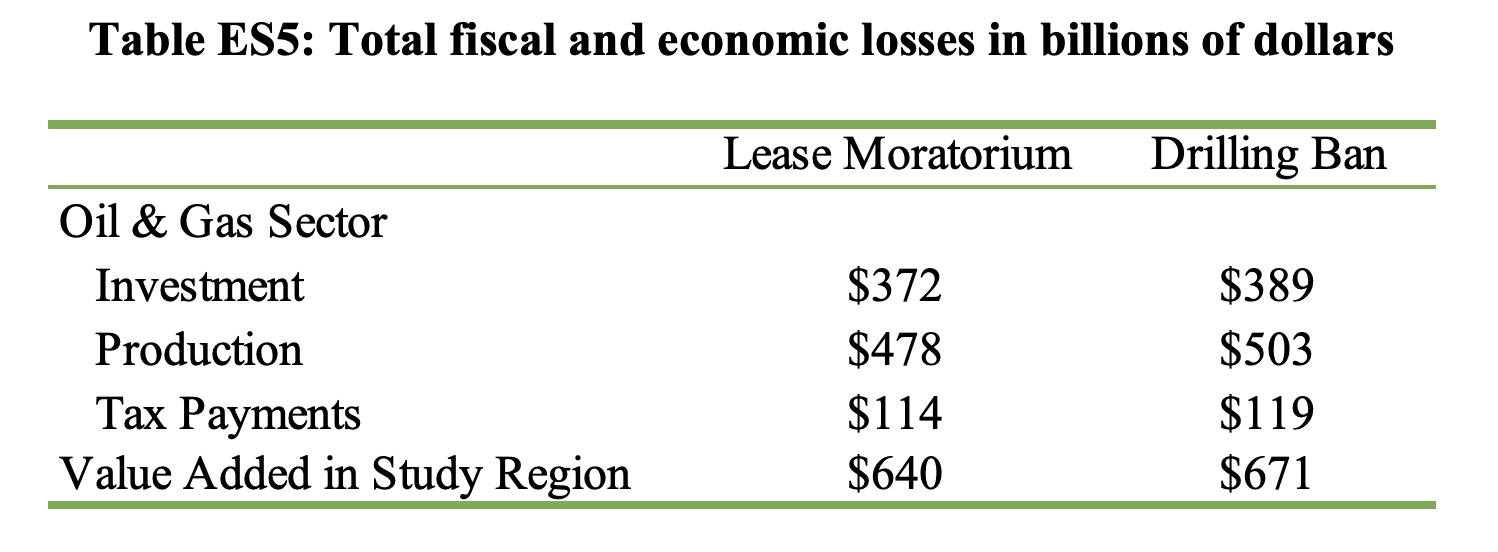Mr. Biden pledged during the campaign to eliminate oil-and-gas permitting on federal lands; doing so would be devastating to Western states. Biden originally indicated that he would ban hydraulic fracturing, which fueled an energy boom in Pennsylvania, but reversed course as Pennsylvania emerged as a state he needed to win in order to obtain the Presidency. Instead, he said he would stop federal permitting on federal lands, which puts the impact almost entirely on the Western states, where most federal lands are located. A University of Wyoming study found that such a ban would result in $670 billion in lost GDP among eight Western states by 2040 and wipe out more than 72,000 jobs annually over the next four years, with no guarantee of reduced global greenhouse gas emissions. By 2036 through 2040, job losses would reach 351,555 annually.
The study, conducted for the Wyoming Energy Authority, examined the economic impact of a ban on drilling as well as a ban on leasing. The federal government owns nearly half of the land in the 11 continental Western states. The eight states the study evaluated were Wyoming, New Mexico, Colorado, Utah, Montana, North Dakota, California and Alaska, which account for about 97 percent of oil-and-gas development on federal lands.
Because lower U.S. oil production would likely to be offset by higher production in oil-producing countries such as Mexico, Canada, Saudi Arabia and other OPEC countries, and because lower U.S. oil production would not necessarily mean lower U.S. oil consumption, the United States would be forced to import oil to meet demand. The lower domestic oil production and higher oil imports would be Biden’s counterlegacy to President Trump’s energy dominance program that had the nation achieve net energy independence for the first time since 1957.
The United States is now the largest oil and gas producer in the world, which helps to deter OPEC from cutting production to increase prices and increases U.S. influence throughout the world. The University of Wyoming report states, “Halting oil and gas development on federal lands reduces an important source of incremental supply to world markets, thus increasing OPEC’s market power and ultimately transferring income from consumers to foreign oil producers.” This phenomenon had recently been stopped through the success of U.S. energy production.
Since oil consumption is not reduced by a drilling moratorium, neither are carbon dioxide emissions. So there is no gain from Biden’s plan, only pain for the federal land states who derive jobs, investment and revenue from energy production. Despite our number one production status, the United States leads the world in lowering carbon dioxide emissions. The Environmental Protection Agency reported last month that U.S. emissions from large facilities fell by nearly 5 percent between 2018 and 2019. But, Mr. Biden is looking to achieve a much more ambitious goal of net-zero emissions by 2050 throughout the economy.
Biden thinks that his energy and climate plan would create 10 million energy jobs in areas other than fossil fuels. But, renewable-energy jobs are often in construction, which are “short-term jobs,” as opposed to “the longer-term jobs” that are in sectors like oil, gas and coal. Also, these renewable jobs pay much less—as much as half as much—as the oil, natural gas, and coal jobs, according to data from the Bureau of Labor Statistics.
Impact of a Lease Moratorium and a Drilling Ban
A moratorium on new leases for oil and gas development on federal lands or a drilling ban would significantly reduce oil and tax revenues and economic growth in the study region. Total lost investment from 2021 to 2040 would be $372 billion under a lease moratorium and $389 under a drilling ban. Lost investment translates to lost production, which would total $478 and $503 billion under a lease moratorium and a drilling ban, respectively. Fiscal losses would amount to $114 billion under a lease moratorium. A drilling ban generates losses in oil and gas tax revenues of $119 billion over the next 20 years, creating a difficult situation for resource dependent states, such as New Mexico, Wyoming and Alaska. Finally, these policies reduce economic growth, causing losses of $640 billion and $671 billion under a lease moratorium and drilling ban, respectively.

The policy would be most detrimental to Wyoming and New Mexico, where most drilling occurs on federal lands. Without new leasing, states would lose the opportunity to generate revenues from new wells on those lands. As a result, those states are projected to lose $304 million and $946 million a year in tax revenue, respectively, through 2025.
Conclusion
Biden’s plan to eliminate oil and gas permitting on federal lands would devastate the economies of the U.S. Western states, where most oil production is produced on federal lands. A drilling ban would result in a reduction in economic growth of $671 billion. Biden, however, probably does not care about the Western oil producing states, which were mostly won by President Trump in the 2020 election. Biden’s policies tend to be based on winning the support of those who oppose energy development on federal lands, although the states which would lose this economic boon will be severely hurt, as would U.S. energy independence.



